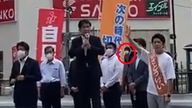Shinzo Abe’s importance in stemming Japan’s economic decline over the last two decades cannot be overstated
Shinzo Abe’s importance in stemming Japan’s economic decline over the last two decades cannot be overstated.
What had been the world’s second-biggest economy before the rise of China had begun to stagnate at the end of 1989 after the bursting of a stupendous asset and property bubble that, at one point, famously saw the land on which the Imperial Palace in Tokyo sits valued at more than the whole of California.
A grim recession was followed by what has become known as two “lost decades” during which Japan suffered low growth and a deflationary phenomenon that caused its consumers to hoard cash rather than spend it.
Background of Abe’s suspected assassin revealed – live updates
A succession of prime ministers came and went, all of them seemingly unable to stem the decline – seven of them in the 1990s alone.
There was similar drift for much of the early 2000s, despite the charismatic Junichiro Koizumi, before Mr Abe arrived in 2006 as the youngest holder of the post for 65 years. His first administration lasted only a year but he then returned in 2012 after a campaign in which he explicitly promised to end the stagnation.
Central to this was what became known as ‘Abenomics’ – a three-pronged approach (Mr Abe specifically referred to ‘three arrows’) of ultra-loose monetary policy, flexible fiscal policy in the form of higher government spending and structural reforms aimed at bolstering the country’s labour market at a time when Japan’s population was ageing rapidly.
The policy was decried by critics as having been tried before but, on the whole, it did more to stem Japan’s post-1989 decline than anything that had been previously attempted.
Monetary policy was certainly loosened after Mr Abe appointed Haruhiko Kuroda as governor of the Bank of Japan governor. Interest rates went into negative territory and an asset purchase programme – quantitative easing in the jargon – launched on a bigger scale than in comparable economies. To this day the BoJ owns a bigger proportion of public debt than, say, the US Federal Reserve or the Bank of England.
On the fiscal side, things were less successful. Public spending was increased but the government’s reluctance to increase borrowing resulted in a misguided decision to go ahead with a rise in consumption taxes from 5% to 8% that Mr Abe inherited from his predecessor. It had the effect, naturally enough, of dampening consumer spending and tipped the economy into another recession.
The third arrow of Abenomics, structural reform, may prove to be Mr Abe’s lasting legacy. Arguably Mr Abe’s biggest achievement was to increase female participation in the jobs market in a country where most workplaces were traditionally male dominated. Moreover, he persuaded the Japanese, in part, to abandon their traditional vehement opposition to immigration. There are now some districts in Tokyo where the proportion of the population that was not born in Japan is as high as 15%. That latter factor may have been because Mr Abe was so evidently a patriot – some would say a nationalist – who was unashamedly proud to be Japanese and whose tougher line on foreign and defence policy, particularly towards China, made the public more willing to accept higher levels of immigration when it came from him.
Unemployment halved during Mr Abe’s term of office. Other reforms he made also helped. He pulled off two huge trade deals – one with the US and one with the EU – that benefited Japanese industry while the country’s energy market was also liberalised, bringing down costs to consumers and businesses.
Read more: Former Japanese prime minister Shinzo Abe dies after being shot while giving speech
Another key achievement was taking on Japan’s powerful farming lobby – a key priority when Abenomics was launched – which also benefited consumers. Crucially, following a string of governance scandals at companies like Olympus, he also pushed through corporate reforms. It attracted more foreign investment to Japan than had been seen in the previous 20 years and breathed life into the previously moribund stock market. And he was also a key figure in securing for Japan the 2020 Tokyo Olympics – even if the pandemic forced its postponement for a year.
That is not to say Abenomics was an unalloyed success. Japan never achieved the target rate of inflation of 2% he set out to achieve although, ironically, this has now come about as a result of the price shocks that have rocked the global economy this year.
In truth, it is impossible to say whether Abenomics would ultimately have achieved all of its aims, due to the fact that Japan’s economy was derailed – as with so many parts of the world – by COVID-19. Nor was Mr Abe able to do anything to slow the pace of Japan’s demographic decline.
But he probably did more than anyone has to stop the rot that set in at the end of 1989 – while making millions of Japanese people feel better about themselves.


